Energy Efficient Scotland programme: analysis of delivery mechanism
Report exploring how best to oversee the delivery of our programme to improve energy efficiency and promote low carbon heating in Scotland's homes and buildings.
5 Existing Arrangements
5.1 Key points
This chapter outlines the existing situation in Scotland and presents the basis for the Reference Scenario in which the roles proposed for a national delivery mechanism are not addressed in taking the programme forward.
It also provides a summary of ‘where we are now’ in relation to the EES targets and objectives set out in Chapter 3, including an overview of the current state of Scotland’s building stock, a summary of the existing levers and administering organisations currently contributing towards achieving those targets, and the key characteristics of the supply chain and quality assurance providers.
This establishes the status quo from which any changes, whether initiated by a national delivery mechanism or otherwise, will be based.
5.2 Scottish domestic housing stock
According to Housing Statistics for Scotland there are 2.59 million domestic buildings in Scotland, of which 2.49 million are occupied. Of the occupied dwellings, 58.1% are owner occupied, 15.2% are rented privately, 23% are socially rented and 3.7% are vacant private dwellings and second homes. [13]
The 2016 Scottish House Condition Survey[14] provides a snapshot of domestic building condition, based on a survey of 2,850 households, covering all tenures, across Scotland. Comparing data from previous surveys provides a time series with which to approximate the current rate of progress towards targets. Some of the key trends are presented below.
5.2.1 Energy efficiency
Energy Performance Certificates (EPC) were introduced in 2009 to assess the amount of energy needed for space and water heating, ventilation and lighting and, where applicable, energy generated through renewables (such as photovoltaics and solar hot water heating).
In general, the interventions with a lower cost that create less disruption to occupants are installed first, however, these are only sufficient to obtain the lower EPC ratings. To achieve EPC targets that align with EES targets (EPC C+), increasingly deep retrofits and bespoke interventions are required, including the installation of renewable and low carbon energy supply systems. These interventions are in most cases associated with increasing cost and degree of physical change to properties.
The trajectory of energy efficiency installation in Scotland is in line with the rate required to meet EES targets, although there has been a slowing of progress in recent years. There are significant variations in EPC ratings across different housing types, with a smaller proportion of owner-occupied properties achieving EPC Band C or above. More details around the measures typically required to achieve different EPC ratings, and Scotland’s progress to date, is set out in Annex 2.
Figure 1: Typical installation measures required to progress to higher EPC ratings
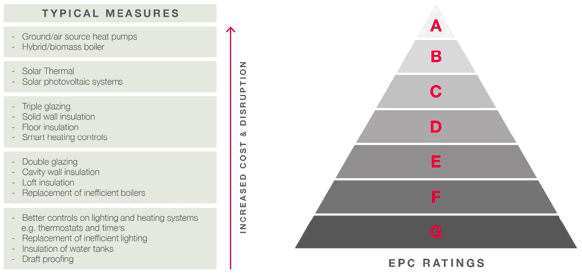
In 2012 an update was made to the Standard Assessment Procedure (SAP) methodology. Using SAP 2009 provides a longer time series from which to understand the rate of progress, whereas using SAP 2012 provides a more accurate representation of the current situation. Figure 2 shows the progress towards the EES target of achieving EPC C or better for all buildings by 2040, compared with a simple linear projection towards the 2040 target.
This shows that the rate of progress since 2010 has been in line with the rate required to meet EES targets. In 2013 and 2014, the rate of progress exceeded the required rate, however, this was followed by a stagnation in 2015, before return to a moderate rate of progress in 2016.
The distribution of energy efficiency varies widely between stock of different tenures (Figure 3). Over half of buildings in the social rented sector already meet the EPC C+ target, with only 7% EPC E or below. In contrast, 34% of owner occupied and 37% of private rented buildings achieve the target, with 20% and 26%, respectively, EPC E or below.
Figure 2: Progress in number of domestic buildings achieving EPC C+, based on SAP 2009 and SAP 2012 methodologies, compared with a projected linear rate of progress to achieve the EPC C+ EES target for all domestic buildings.
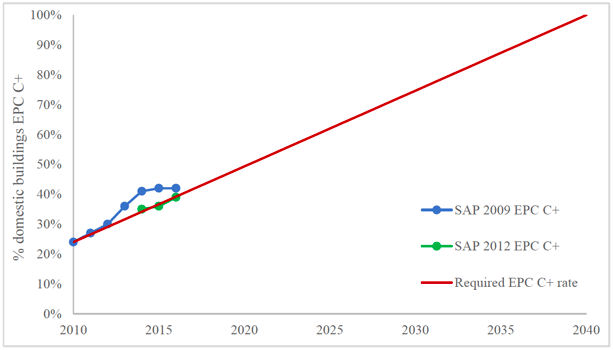
Figure 3: The proportion of buildings at EPC C+, EPC D, and EPC E- in 2016, based on the SAP 2012 methodology, split by domestic tenure.[15]
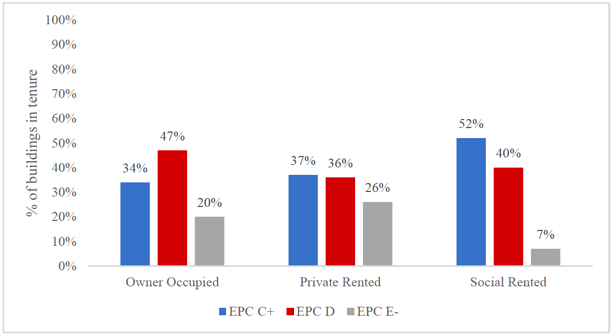
5.2.2 Fuel poverty
In 2016, 649,000 (26.5%) households in Scotland were fuel poor[16], with 183,000 (7.5%) living in extreme fuel poverty[17]. Fuel poverty is transient and households can move into and out of fuel poverty over time as circumstances change. Figure 4 illustrates the composition of fuel poor households. Fuel poor households in Scotland are distributed across all tenures, with 58% owner occupied, 31% in the social rented sector and 11% private rented, showing that energy efficiency improvements across all sectors would impact on fuel poverty.
Figure 4: The characteristics of fuel poor households in Scotland in 2016 (credit: Scottish Government[14]).
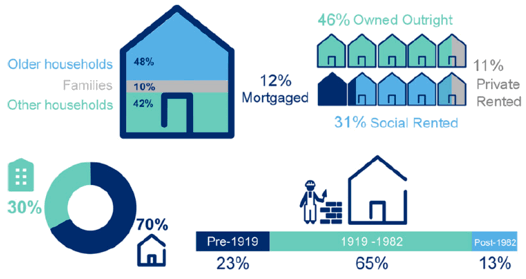
Some 4.3% fewer domestic households were in fuel poverty in 2016 compared to 2015. An analysis of the driving factors behind this attributed 63% of this reduction to lower fuel prices and 35% to energy efficiency improvements14. It is therefore important to note that fuel poverty is not directly correlated to energy efficiency, but is a function of various complex factors, including the price of fuel and the level of household income. Therefore, whilst energy efficiency improvements can contribute to reducing fuel poverty, the impact of changes in other variables also need to be considered when assessing the overall prevalence of fuel poverty.
5.3 Scottish non-domestic building stock
There are approximately 200,000 non-domestic buildings in Scotland, 10% of which are in the public sector and, in comparison to the domestic sector, much less is known about the energy efficiency of these buildings. In contrast to domestic EPC assessments, which consider both energy performance and carbon emissions, non-domestic EPC ratings are based only on projected carbon emissions. Any building with a floor area over 250m2 that is occupied by a public authority and regularly visited by the public must obtain and display an EPC.
Fifteen percent of non-domestic buildings in Scotland have an EPC rating and, of these, 5% have a rating of EPC B+, 22% are EPC C or D and 73% are EPC E or worse[18]. This sample size illustrates the level of uncertainty in understanding the energy performance of buildings in the non-domestic sector. The EES route map has set out a proposal to create a non-domestic benchmarking standard and to produce a baseline on the current state of the building stock by 2020[9].
5.4 Existing levers for energy efficiency and heat decarbonisation
The current energy efficiency landscape in Scotland consists of a range of levers aimed at promoting, incentivising and enabling the retrofitting of energy efficient technologies and the installation of renewable, low-carbon technologies. These include:
- Free, independent, impartial advice;
- Grants for fuel-poor households;
- Financial incentives such as low/no interest loans;
- Regulation & legislation; and
- Procurement support.
For the purpose of reviewing the existing levers, they have been split into those applicable to the domestic sector and those applicable to the non-domestic sector. These are illustrated in Figure 5 and Figure 6 respectively. Within these two sectors, some levers apply to all buildings, whereas others are targeted at specific sub-sectors.
It is important to note that, in some cases, the longevity of the lever is unclear. For some financial instruments, budgets are determined on a rolling basis for each financial year with no confirmed programme commitment beyond this. In these cases, programmes have been included based on the duration for which a budget has been allocated.
The levers are administered and funded by a wide range of organisations, including the UK and Scottish Governments, alongside several arm’s length or independent organisations. An overview of these organisations is provided in the following section. All levers currently impacting the Scottish building stock have been included to give an appreciation of what is currently contributing towards EES targets. Figure 5 and Figure 6 also outline whether each lever is or is not within the remit of the EES Programme.
Figure 5 A summary of the levers that are currently supporting energy efficiency and low carbon heat improvements in the domestic sector
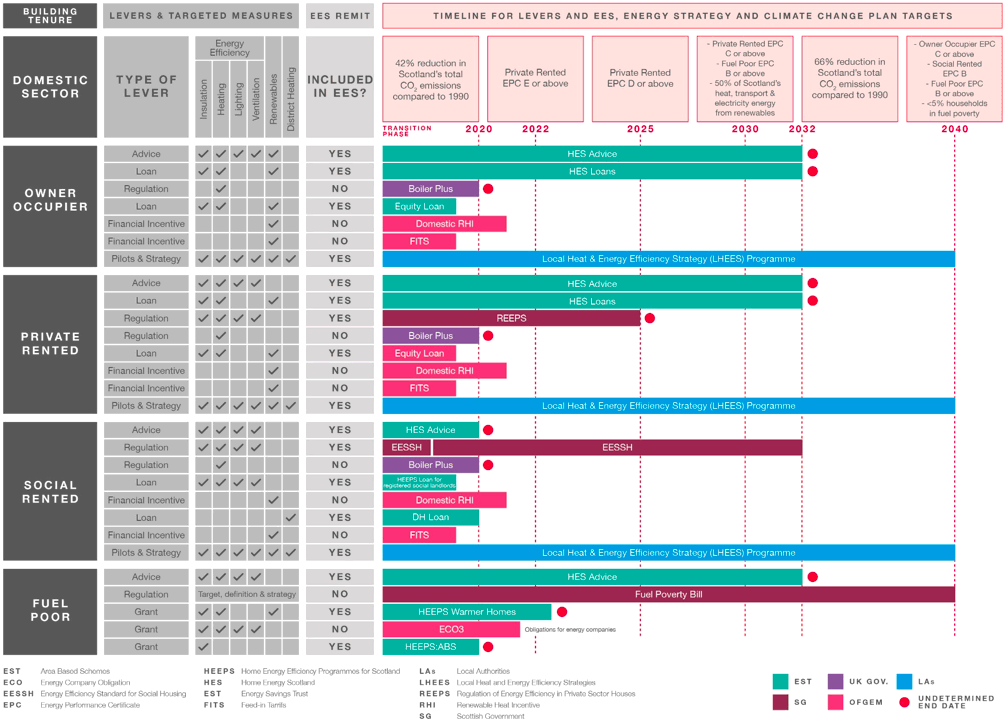
Figure 6 A summary of the levers that are currently supporting energy efficiency and low carbon heat improvements in the non-domestic sector
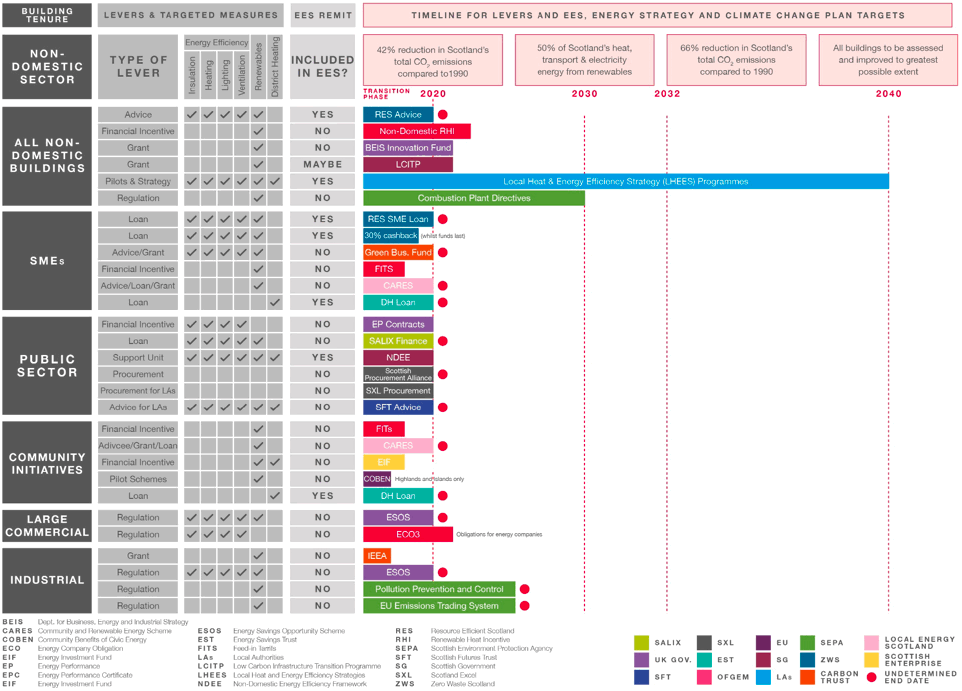
5.5 Existing delivery structures
Figure 5 and Figure 6 demonstrate that the existing levers for building energy efficiency are administered by a wide range of organisations, particularly in the non-domestic building sector. To appreciate the current landscape fully, it is important to understand the responsibilities of each organisation and their relationship to Government, outlined in Table 4 below.
Table 4: Organisations responsible for adminstering levers and their relationship to government
| Administering Organisation |
Description |
|
|---|---|---|
| Energy Saving Trust (EST) |
An independent, not for profit organisation, working on behalf of UK governments to help people save energy. In Scotland it is funded by the Scottish Government and private sector[19]. |
Independent, funded by Government. |
| Zero Waste Scotland (ZWS) |
A not-for-profit company, funded by the Scottish Government to support the delivery of its policies on waste and resource use, energy efficiency and a low carbon economy[20]. |
Directly accountable to the UK and/or Scottish Government |
| Scottish Environment Protection Agency (SEPA) |
A publicly-funded organisation, SEPA is Scotland’s principal environmental regulator. It is required to publish plans and performance reports to the Scottish Government and the Scottish public. Performance is monitored against SEPA’s five-year corporate plans and annual operating plans[21]. |
Directly accountable to the UK and/or Scottish Government |
| Warmworks Scotland |
Warmworks Scotland is a partnership between the Energy Saving Trust, Everwarm and Changeworks to deliver the Scottish Government’s flagship national fuel poverty scheme, Warmer Homes Scotland.[22] |
Independent Joint Venture, funded by Government. |
| Carbon Trust |
An independent, private company, funded by a range of government organisations, of which DEFRA is the main contributor[23]. |
Independent, funded by Government. |
| Local Energy Scotland |
A consortium, set up by the EST, Changeworks, The Energy Agency, SCARF and The Wise Group in order to administer and manage CARES, which is funded by the Scottish Government[24]. |
Independent, funded by Government. |
| Ofgem |
A non-ministerial government department and an independent National Regulatory Authority, recognising by EU directives. It is governed by the Gas and Electricity Markets Authority (GEMA) and recovers its costs from the licensing fees paid by the companies they regulate[25]. |
Independent and self-funded |
| Salix Finance Ltd. |
An independent, not-for-profit, government funded organisation. In Scotland it is funded by the Scottish Government and is focussed on improving energy efficiency in the public sector[26]. |
Independent, funded by Government. |
| Scottish Enterprise |
A non-departmental public body of the Scottish Government. It is Scotland’s main economic development agency. Its investment arm, the Scottish Investment Bank (SIB), aims to increase the supply of finance and support the growth of Scottish SMEs[27]. |
Directly accountable to the UK and/or Scottish Government |
| Scottish Housing Regulator (SHR) |
The independent regulator of Registered Social Landlords and local authority housing services in Scotland. It is a non-ministerial department, directly accountable to the Scottish Parliament. They regulate social landlords to protect the interests of people who receive services form them[28]. |
Independent, funded by Government. |
5.6 Current state of delivery aspects
The EES objectives described in Chapter 4, incorporate targets for enhancing the delivery of EES to help maximise the wider benefits of the programme. To understand whether there is a strategic need for change in these areas, this chapter summarises the existing characteristics and perspectives of the supply chain and the services provided by the main organisations involved in quality assurance and customer protection.
5.6.1 The supply chain
In October 2017, the Energy Saving Trust published a report[29] providing insights into the energy efficiency and low carbon markets from both demand and supply perspectives. This included a characterisation of the current supply chain for energy efficiency in Scotland, based on responses from 80 suppliers.
A key theme was the importance of SMEs in the supply chain. SMEs are often a householder’s first port of call for energy efficiency advice. The Scottish Government and Local Authorities must therefore ensure that SMEs provide the necessary advice and deliver high quality home improvements that reduce energy consumption, especially space heating.
In addition, the EST report found that many suppliers are cautious about the scale of opportunities that will be available to them over the next 3 years. The Government therefore faces the challenge of communicating the opportunities on offer from the EES programme, so that suppliers can invest in the capacity and skills required to deliver programme targets.
5.6.2 Quality assurance
There is a range of organisations and teams within Scotland responsible for quality assurance and consumer protection related to energy efficiency in buildings. The roles of some of these are presented below, however there are additional contributors, including ombudsman organisations and independent guarantee schemes.
Table 5: Summary of quality and regulatory bodies
| Body |
Description |
Responsibilities |
|---|---|---|
| Trading Standards Scotland |
The national team for trading standards in Scotland. It is funded by the Department for Business Energy and Industrial Strategy (BEIS) and managed by the Convention of Scottish Local Authorities (COSLA). |
|
Table 5: Summary of quality and regulatory bodies
| Local Trading Standards |
Aim to maintain a fair-trading environment by supporting legitimate businesses and enforcing compliance. In Scotland, these are delivered by small teams within local councils[31]. |
|
|---|---|---|
| Citizens Advice Scotland |
Has responsibility for consumer advice and advocacy within the Scottish consumer protection landscape. |
|
| Heat Trust |
Sets out a common standard for the quality and level of customer service that heat suppliers should provide their customers. It also provides an independent process with the Energy Ombudsman for settling any complaints between consumers and their heat supplier[33]. |
|
| Ofgem |
Ofgem can apply to the courts for an order to stop non-compliance with certain consumer regulation including the Enterprise Act (2002), Consumer Rights Act (2015), and Business Protection from Misleading Marketing Regulations (2008)25. They also have consumer protection codes for Renewable Heat Incentive (RHI) provision, whereby all heating systems and installers must be Microgeneration Certificate Scheme (MCS) certified. |
|
5.7 Summary of existing arrangements
This chapter presented a summary of the existing framework. The key points are as follows:
- 39% of domestic buildings currently meet the domestic EES target of EPC C or above;
- The rate of progress in the domestic sector has previously exceeded the average rate required to meet EPC targets, however progress stagnated in 2015;
- Energy efficiency varies widely between the stock of different domestic tenures, with a larger proportion of social rented buildings currently achieving ESS targets compared with private rented and owner-occupied buildings;
- There are 649,000 fuel poor households in Scotland aggregated across all tenures. Whilst energy efficiency improvements will impact this, the contribution of other factors such as fuel price and income also need to be considered;
- There is much greater uncertainty around the energy performance of buildings in Scotland’s non-domestic sector as only 15% of non-domestic buildings have an EPC rating;
- There is a range of levers currently acting on the energy performance of Scotland’s buildings. The longevity of these levers, and the measures they target, vary;
- Levers are administered by a wide range of organisations, particularly in the non-domestic sector. These organisations have different relationships to the Scottish Government and, as such, only certain levers are within the remit of EES;
- The supply chain consists of predominantly smaller companies with fewer than ten employees. Suppliers are currently cautious about the future market demand and the scale of opportunities that will become available; and
- There is a large number of organisations, standards and processes which contribute to quality assurance and customer protection for energy efficiency and low carbon retrofits in Scotland.
Contact
Email: james.hemphill@gov.scot
There is a problem
Thanks for your feedback